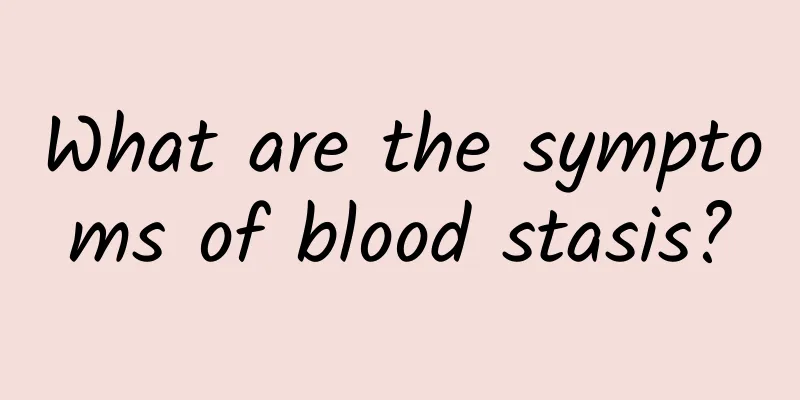What are the symptoms of blood stasis?

|
Qi and blood stasis refers to the stagnation of qi and blood, which is explained from the perspective of traditional Chinese medicine. When qi and blood stasis occurs, the body's qi and blood often do not flow smoothly, resulting in poor blood circulation, which in turn causes a variety of symptoms. The most common one is chest and rib fullness. Due to blood stasis, some cardiovascular diseases may be induced, causing breathing abnormalities, resulting in symptoms such as palpitations. Symptoms of Qi and Blood Stasis 1. Qi stagnation and blood stasis refers to a pathological state in which blood circulation is obstructed and blood stasis occurs due to stagnation of Qi. 2. Qi stagnation and blood stasis are mostly caused by emotional injury, depression, and Qi stagnation, which lead to blood stasis. The liver is responsible for regulating qi and storing blood. The regulating function of liver qi plays a key role in regulating qi. Therefore, qi stagnation and blood stasis are often closely related to liver failure to regulate qi. 3. Clinically, common symptoms include fullness and pain in the chest and flanks, mass accumulation, and accumulation of symptoms. The lungs control qi, regulate the body's qi, and assist the heart in transporting blood. If pathogens block the lung qi and the functions of ascending and descending are impaired, over time it can lead to qi stagnation and blood stasis in the heart and lungs, resulting in symptoms such as cough, asthma, palpitations, chest pain, and blue lips and tongue. 4. Qi stagnation can lead to blood stasis, and blood stasis must be accompanied by qi stagnation. Because Qi stagnation and blood stasis are mutually causal and often coexist at the same time, it is often difficult to clearly distinguish which comes first. Factors such as sprains and trauma can lead to the simultaneous formation of qi stagnation and blood stasis. However, no matter what the cause of qi stagnation and blood stasis is, it is necessary to distinguish the priority of qi stagnation and blood stasis. Application of Traditional Chinese Medicine Qi stagnation and blood stasis (syndrome) treatment Main symptoms: stabbing pain that is resistant to pressure, persistent pain, dull or dark complexion. Side effects: chest and flank distension, wandering pain, irritability or depression; or delirium, or madness; or hard lumps under the flanks; or bluish lips, nails, and skin; or thirst but wanting to spit out water instead of swallowing it; or purple spots on the skin, or silky blood streaks on the skin, or exposed blue veins in the abdomen, or swollen and painful blue veins in the lower limbs; or black stools like tar; or dysmenorrhea, amenorrhea, and persistent lochia, with dark purple blood mixed with blood clots. Tongue and pulse: The tongue is dark purple or has ecchymosis, the pulse is thin and wiry or deep and wiry, or it is intermittent. Treatment principles: Promote blood circulation, remove blood stasis, promote qi circulation and relieve pain. Representative prescriptions: Xuefu Zhuyu Decoction, Shentong Zhuyu Decoction, Fuyuan Huoxue Decoction, Shaofu Zhuyu Decoction, Tongqiao Huoxue Decoction, Gexia Zhuyu Decoction, etc. |
<<: What are the symptoms of infant brain nerve damage
>>: What are the symptoms of infection after medical abortion?
Recommend
What should I do if I have severe diarrhea and watery stools?
Many people often suffer from diarrhea or watery ...
What are the effects and functions of Pittosporum tobira bark?
The medicinal value of Pittosporum tobira bark is...
Is rhabdomyolysis caused by crayfish?
Rhabdomyolysis is a relatively serious disease th...
How to regulate male yin deficiency and hyperactivity of fire
It is also common for men to have Yin deficiency ...
Labia minora repair surgery
The labia is an important part of the female body...
What causes a long menstrual cycle?
Under normal circumstances, every girl will have ...
It is normal to postpone your period for a few days.
Menstruation is the normal physiological cycle of...
What to do if there is a small hole after squeezing out the acne
If acne stays on the face for too long, it will m...
Remove mosquito bite scars
Summer not only has annoying high temperatures, b...
What to do about allergic dermatitis during lactation
When it comes to allergic dermatitis, I believe e...
Dehumidifying tea recipe
Every summer, the climate is particularly humid a...
Principles of antibiotic use
In our country, there is a situation of blindly u...
Are there any side effects to lip hair removal?
There are many tiny hairs on the human body, whic...
How to remove the white stuff on armpit hair? There are some tips
Many people have white stuff on their armpit hair...
What is the difference between eczema and herpes?
I have often had eczema. In fact, eczema is a ski...









